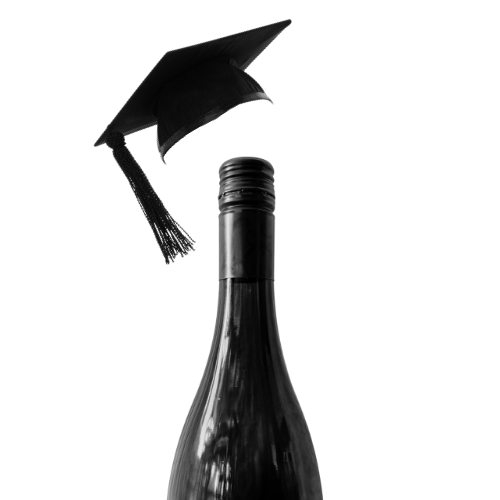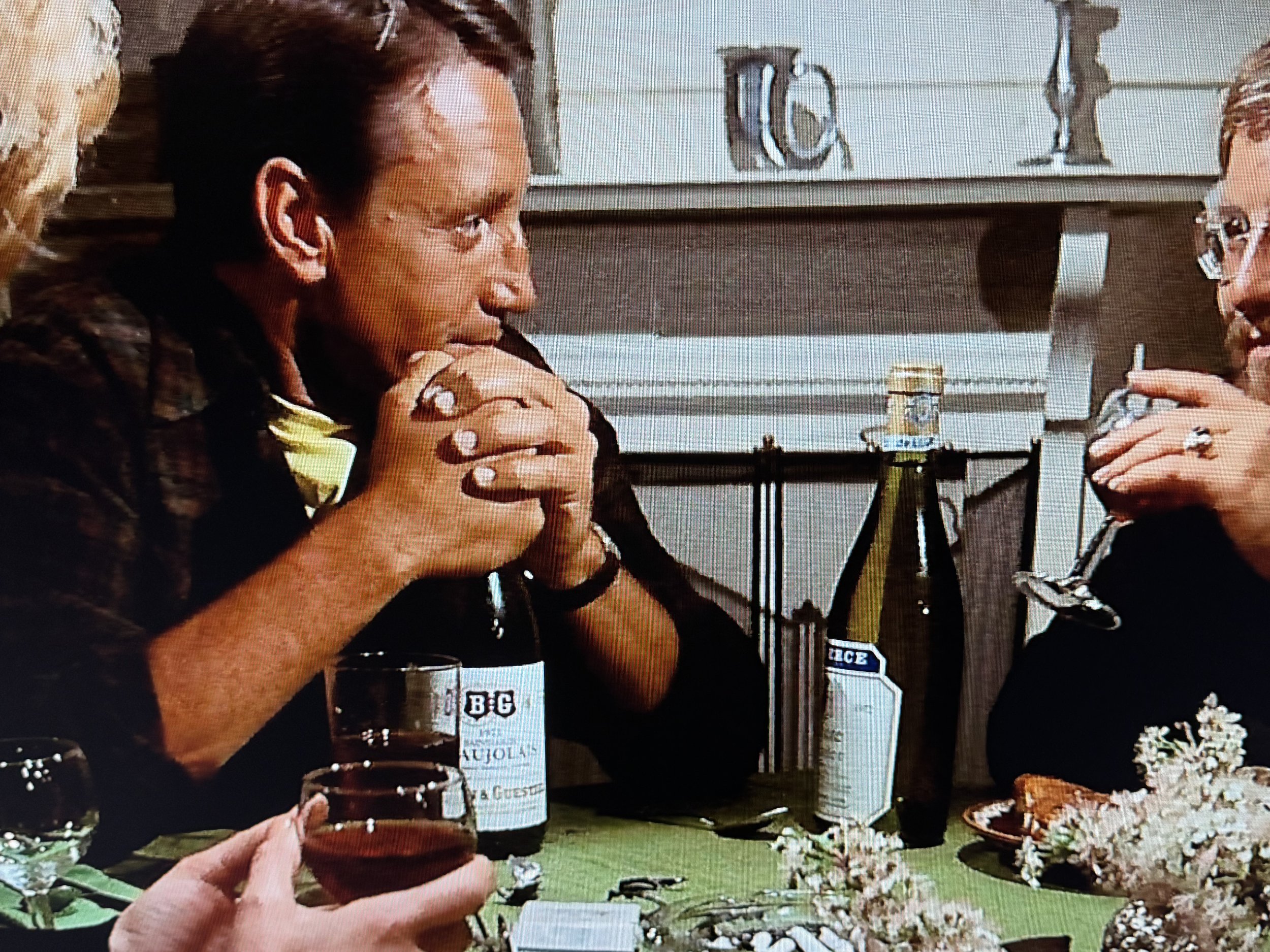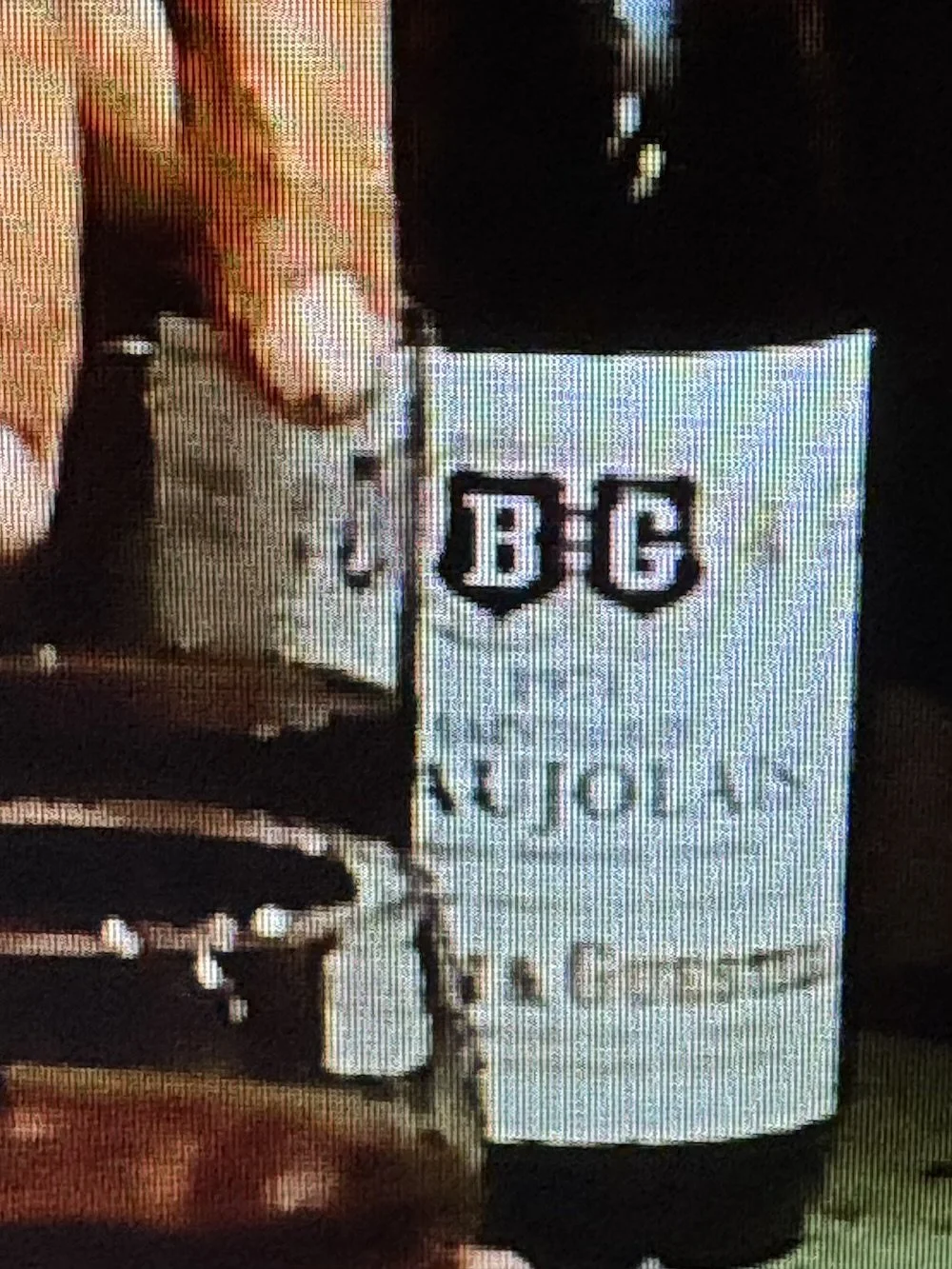Jaws: A Deep-ish Dive into Its Bottles
Hooper brings some select wines to dinner in the 1975 movie, Jaws.
In This Post:
Class Warriors
Guess What’s Coming to Dinner
Un-snooting Wine Snootiness
The Booze Tally
Your Turn
Class (or Glass) Warriors
Chief Brody has had what is arguably one of the worst days of his career in the tourist mecca of Amity Island: At what should’ve been a day of celebration – local fishermen having caught a tiger shark assumed to be the man-eater — shark expert Matt Hooper expressed doubt that they’ve caught the right set of jaws. And grieving mother Mrs. Kitner has publicly shamed Brody for not protecting the people of Amity, most especially her son, Alex, who recently became Shark Victim No. 2. (Number 3, actually, if you count that poor black Lab, Pippit.)
At the dinner table that evening, Brody shares a touching moment with his youngest son, Sean, who mirrors his old man’s gestures and facial expressions. When Brody contorts his face into the snarl of a monster, Sean answers with his own adorably toothless rendition.
Little Sean, aping the old man’s grimace.
Enter Hooper, wielding two bottles of wine: a red and a white. “I didn’t know what you’d be serving,” he explains.
Ellen seems surprised by the offering. “Oh, wine! How nice!” After all, Amity Island is portrayed as a community of more approachable and less “foo-foo” ethanols – in particular, beer and hard spirits. In the opening scene, Chrissie’s would-be suitor, Tom Cassidy, avoids becoming Bruce the Shark’s second course by passing out drunk from one too many Falstaff Beers. Later, Ellen Brody hands her husband a rocks glass of what looks to be whiskey and asks: “Wanna get drunk and fool around?” As partial payment for his services, shark hunter Quint asks for a case of apricot brandy, a favorite of area fisherman at the time. Later, aboard the Orca, Quint, Hooper, and Brody knock back glasses of the spirit while bonding over their “battle scars.”
Throughout the film, Matt Hooper is portrayed as the antithesis of Quint’s working-class ethos: “You got city hands, Mr. Hooper. You been countin’ money all your life.” It’s a populist resentment that defines their dynamic throughout the film. Hooper’s proffering of wine for the Brodys underscores both his economic status as a “wealthy college boy” and as an outsider. His arrival marks the only time wine is ever introduced or mentioned in the film.
Guess What’s Coming to Dinner
The story of “Jaws” takes place in 1973 (the novel) or 1975 (the movie), when the world market was still dominated by French wines. The 1976 “Judgment in Paris,” in which Napa Valley wines were judged (through a blind tasting) superior to comparable French selections, was not yet a twinkle in a vintner’s eye.
A closer look at the dinner and post-dinner scenes in “Jaws” reveals what Hooper chose to bring: A 1972 Barton & Guestier Beaujolais, and what some internet sleuths have determined to be an A. de Luze & Fils Chassagne-Montrachet (based on the limited views of the bottle in the movie and on the mention of Montrachet in the book). Both wines originate in the Burgundy region of France.
Beaujolais
A bottle of B&G Beaujolais.
Made from the Gamay grape, Beaujolais is considered the poor relation to Burgundy’s more prestigious Pinot Noirs. Each autumn, just before Americans observe Thanksgiving, the French harvest is celebrated with the release of Beaujolais Nouveau, a lighter-bodied, easy-drinking red wine that’s a versatile partner to a wide range of dishes – including your Thanksgiving turkey.
Beaujolais is distinguished by winemaking techniques that protect the grape’s signature fruit and floral aromas. A glass of Beaujolais takes me back to the free and easy days of childhood summers — those days we were given spending money for the local convenience store, and we stuffed our pockets with Sweet-Tarts, Jujyfruits, Runts candies, watermelon Jolly Ranchers, Cinnamon Red Hots, and Fruit Stripe and Hubba Bubba gums.
Many of the wine aficionados I know turn up their noses at the mention of Beaujolais. Alas. Beaujolais is a delightful and whimsical wine – a glassful of happy memories.
Barton & Guestier: This winemaking powerhouse sources grapes and produces wines from 23 appellations and 20 different grape varietals throughout France. Three-hundred – yes, 300! – years after their founding, they still export their wines to 130 countries around the world.
Where to find contemporary Beaujolais: We pick up a damned decent Louis Jadot Beaujolais from our local Vons for ~$12.00. This is my go-to “daily drinker.” You can find more robust versions of Beaujolais at your local wine shop for $15 – $30. Look for the friendly and more perfumed Fleurie or Brouilly, or the richer and more age-worthy Morgon or Moulin-à-Vent.
This wine region is known for its grand cru Chardonnays – high quality white wines sourced from single vineyards. The term “Chassagne” likely derives from the Latin, Cassaneas, meaning “the place planted with oak trees.” The vineyards are more than a thousand years old, and the hillside plantings grow on Jurassic lands. Who knows? Maybe T-Rex liked to relax with a good glass of Chard.
Featuring a refreshing acidity and minerality, plus toasty/nutty and/or buttery aromas, Hooper’s selection would pair well with white meats and fishes.
Where to find contemporary Chassagne-Montrachet: Look for it at your local wine shop, or even retailers like Total Wine, but expect it to lighten your wallet: Prices can range from $50 well into the thousands of dollars.
“Un-Snooting” Wine Snootiness
Hooper’s selections suggest someone who’s comfortable with and knows wine well enough to pick a versatile red and a distinctive white. Brody, however, “un-snoots” any sense of wine snootiness by first pouring himself a full pint glass of the Beaujolais (atop whatever he was drinking beforehand), and later by swigging the Montrachet straight from the bottle.
The message is clear: On Amity, alcohol is strictly utilitarian: It’s a relaxant, an aphrodisiac, and an escape from the pain, tedium, and occasional terror of everyday life. Snobs need not apply.
Here’s to swimmin’ with bow-legged women!
The Booze Tally
Here’s the alcohol we found throughout the movie:
Falstaff Beer (opening beach scene): This was a popular commercial brand in the 1960s and early 1970s, and its lineage can be traced back to the Lemp Brewery of St. Louis, Missouri. Those of you who are into haunted history might recognize the name “Lemp.” The family’s mansion is one of the most notoriously haunted properties in the U.S.
Glasses of whiskey and an offer to “fool around.” (Brody home)
Rot gut (moonshine) and an ignored warning: “Don’t drink that.” (Quint’s shack)
The crumpling of a beer can versus the crumpling of a coffee cup. (Aboard the Orca)
Apricot brandy. (Aboard the Orca)
The wines:
Red wine: 1972 Barton & Guestier Beaujolais
White wine: 1970-ish A. de Luze & Fils Chassagne-Montrachet
Your Turn
Did you find more booze throughout Jaws? Let us know!



